- Karachay folk music
- Special tunes
- The classes of Karachay folk music
- Class 1: Rotating and plagal motion (№ 1−8)
- Class 2: One or two short lines and their variations with x(1)1 cadences (№ 9-37)
- Class 3: Four short lines with (1) main cadence (№ 38-53)
- Class 4: Four short lines with the first line ending on the key note, with a (pseudo) domed structure and 1(x)y cadences (№ 54−62)
- Class 5: Four short lines with (VII) main cadence (№ 63−70)
- Class 6: Four short lines with (2) and (b3) main cadences (№ 71−105)
- Class 7: Four short lines with (4/5) main cadences (№ 106−115)
- Class 8: Four short lines with (4/5) main cadence and a higher beginning (№ 116−138)
- Class 9: Four short lines with (7/8) main cadences (№ 139−145)
- Class 10: One- or two-lined tripodic tunes (№ 146–186)
- Class 11: Tunes with four tripodic lines (№ 187–199)
- Class 12: Jir tunes (№ 200–278)
- Class 13: Four long lines with arched (domed) structure (№ 279–287)
- Connections between Hungarian and Karachay folk music
Class 6: Four short lines with (2) and (b3) main cadences (№ 71−105)
The general scheme of tunes in class 6 describes evenly descending four-lined tunes with a typically higher first line, interim lines in mid-register and a lower fourth line. Several tune types emerge from this general pattern. The melody lines of one descend in step progression –these tunes appear to be of a more recent development. The structure of another type is more symmetrical, more dignified so to speak, analogously to the Hungarian and many other ethnicities’ “psalmodic” style, therefore it is referred to by this label hereafter. The Karachay psalmodic tunes are characterized by a high first line closing on the 4th or 5th degree. Their second and third lines are often similar, moving around the middle of the scale mostly on E-D-C notes and closing on C (line 3 is more variable). The fourth line descends to the base note from the 5-7th degrees. The tunes with 5(b3)1 cadences are less closely, those with 5(b3)b3 cadences are more markedly similar to the Hungarian-Anatolian psalmodic tunes, emphatically to the Anatolian ones (Sipos 1997, 2001). Let us see these groups in detail.
The first line of group 6.1 with (2) main cadence descends to degrees 2-b3, the third line ends on the 2nd degree. The cadences are declining and the lines also have a downward tendency which all lend the tunes a descending sequential character. The cadences of subgroup 6.1a are b3(2)1. № 71−74 and the first part of Ex.6.1 belong here.
The cadences of № 74−77 in subgroup 6.1b are 4(2)1/2, those in subgroup 6.1c (№ 78−81) are 5(2)x. (№ 80 is unique with its undulating first line.) Several tunes in group 6.1b-c can be ranged between the sequential and the psalmodic styles, and many of 6.1c could directly be subsumed under 6.1c, were their main cadence b3 instead of 2. They are actually melody variants of groups 6.3 and 6.4 with a different main cadence. Typically, their first line ends on the 4th or 5th degree, and their third line often ends on b3.
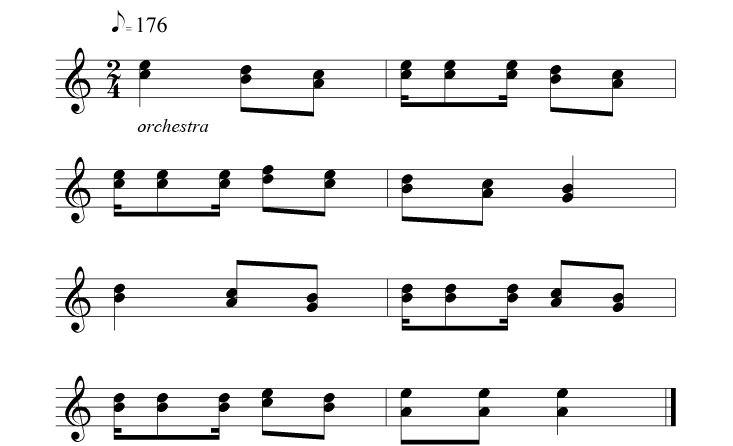
Ex.6.1. Four short lines with (2) main cadence
Most tunes in group 6.2 close on b3. While № 82 and Ex.6.2. fit in well with the Hungarian and Anatolian psalmodic tunes, the undulating first line of № 83 renders it unique and is ranged here for want of a better place.
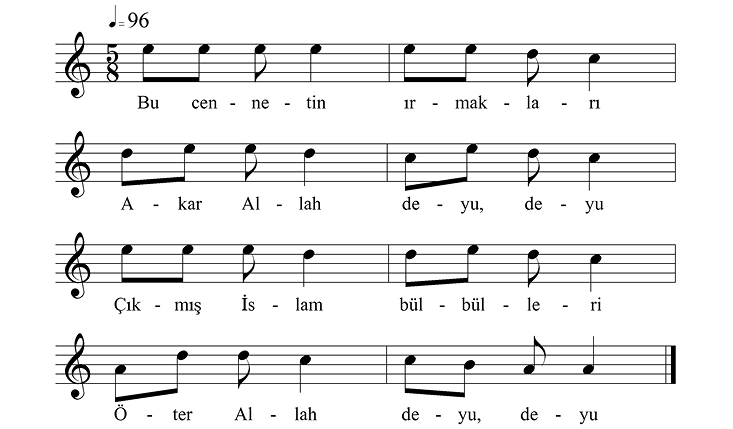
Ex.6.2. Four short lines with (b3) main cadence
The tunes in group 6.3 are descending as the cadences 4(b3)2/1 indicate often with the character of step progression. The tonal range of many tunes here is around the octave. № 84−88 and Ex.6.3 belong here.8
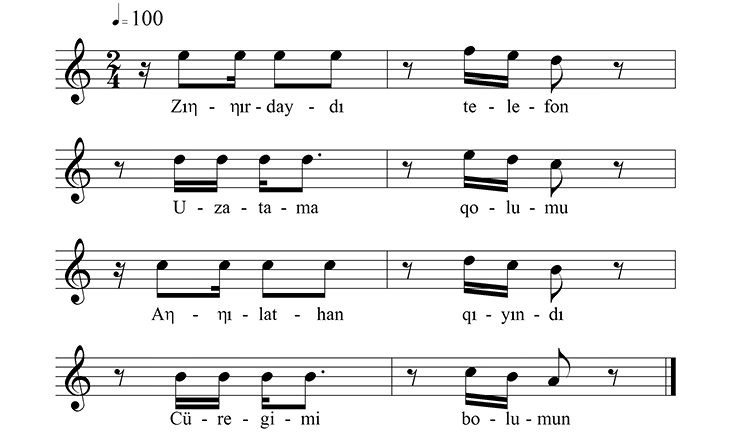
Ex.6.3. Four short lines with (b3) main cadence and sequential descent
Groups 6.4−6.7 include psalmodic tunes and related descending melodies with (b3) main cadence. Unlike the previous group, this one is not dominated by descent in step progression.
In group 6.4 the first line of the two tunes (Ex.6.4 and № 89) ends on degree 4.
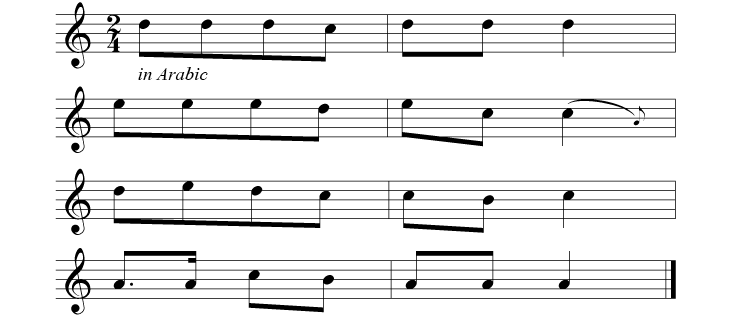
Ex.6.4. Four short lines with (b3) main cadence and psalmodic character
The first line of tunes in groups 6.5 and 6.6 ends on the 5th degree, with the tunes of 6.6 moving higher in general.9 № 90−9510 and Ex.6.5 belong to group 6.5 with predominantly 5(b3)1 cadences, but № 90 has 5(b3)VII(!). Group 6.6 in which the descent starts higher includes № 96−98 and Ex.6.6. The cadence of the third line is normally 1, rarely b3 or 4. Ex.6.6, a Turkish religious song, clearly reveals the similarities – and differences – between Anatolian and Karachay tunes of this structure.
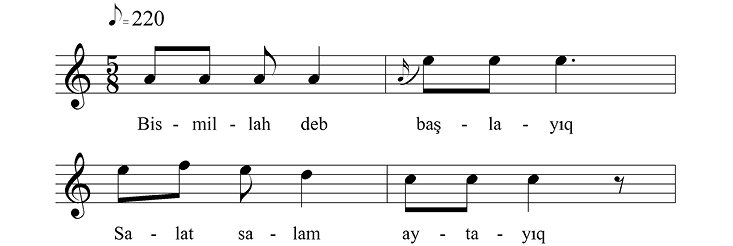

Ex.6.5. Four short lines with (b3) main cadence and psalmodic character
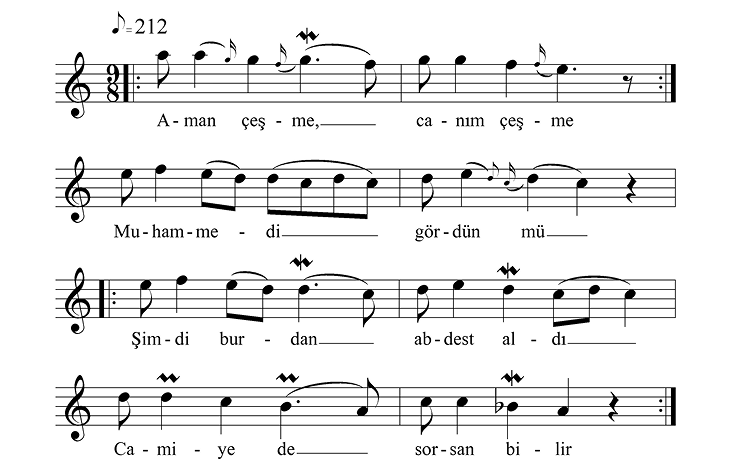
Ex.6.6. Four short lines with (b3) main cadence and high-starting first lines
(Anatolian tune)
The distinguishing feature of the tunes in group 6.7 is the termination of their high first line on degree 7 or 8. № 99−10211 and Ex.6.7 have an Aeolian-Phrygian character. These tunes are closer to the Hungarian descending tunes than to the “psalmodic” ones. The group is rather heterogeneous, cohered mainly by formal rather than essential features. Besides, this is the only group in this class that also includes tunes using scales of mixolydian character (even though they only number three, and two have (2) for their main cadence, to boot) (№ 103−10512).
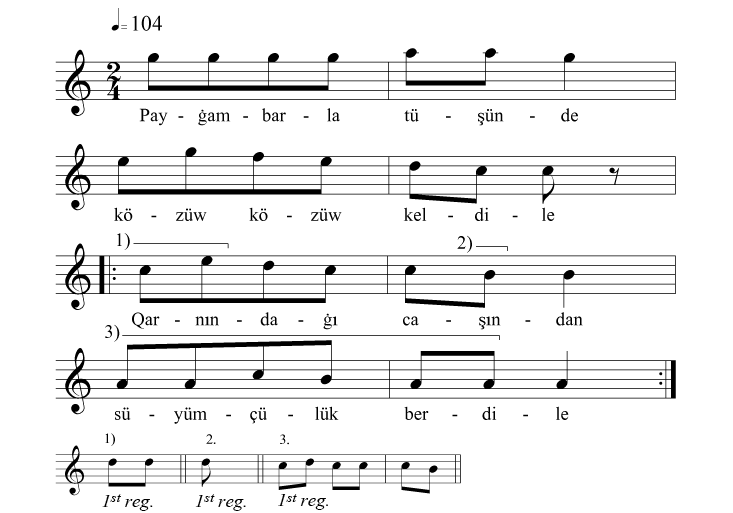
Ex.6.7. Four short lines with (b3) main cadence and high-starting first lines
8 № 85 with 5(b3)1 cadences is ranged here because it is close kin of № 86.
9 № 90 exemplifies well how exchangeable the main cadences (b3), (2) and even (1) are in this group. № 95 is unique for its undulating motion.
10 № 95 has four very short lines, and № 95 has 6(b3)1 cadences.
11 Several of them resemble the Hungarian descending tunes with 7(b3)x cadences. In some cases degree 6 appears to stand in place of 7. № 101−102 are close variants.
12 № 103−104 have (2) main cadence, № 103 is from Otarov, № 104 from a professional Karachay singer.
